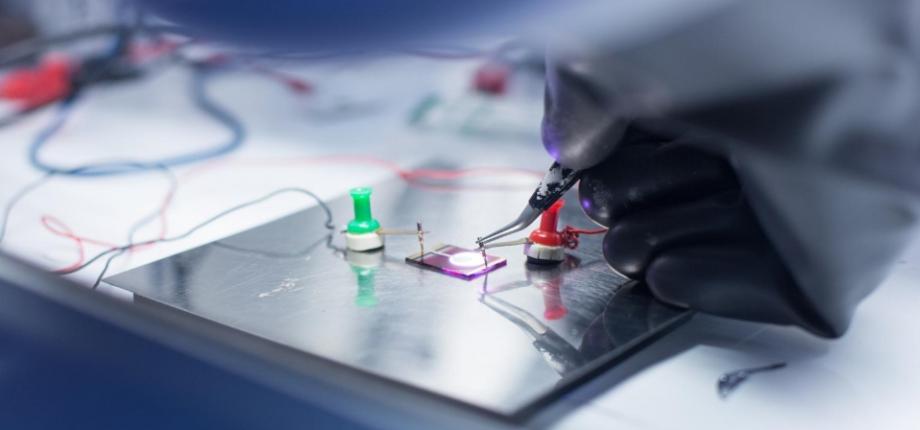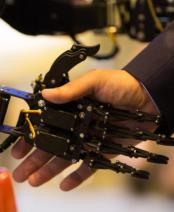Master Year 1 Electrical Engineering for Communications & Information Processing

| Year | Master Year 1 |
| Program | Electrical Engineering for Communications & Information Processing |
| ECTS Credits | 60 |
| Language | English |
| Orientation | Industry and Research |
| Location | Évry Campus |
| Course duration | 12 months, full time |
| Course start | September |
| Degree awarded | Master’s degree on completion of the second year of the Master’s program |
WHY ENROLL IN THIS PROGRAM?
Asset n° 1
Acquire solid core science knowledge
Asset n°2
Choose from four majors addressing key current issues in the field
Asset n°3
Benefit from a practical approach based on individual and group projects
This first year of the Master’s program in Electrical Engineering for Communications provides students with courses in the basic sciences in English, as well as a French language course. Students can choose from two majors that will set the path for their specialization in the second year.
The first major is Telecommunication Networking and Multimedia (TNM) and DATA Analysis and Pattern Classification (Datapac). It aims to provide the foundations to understand, practice, and contribute to the development of new-generation communication techniques and networking, content coding and delivery systems such as 5G networks, connected devices, machine-to-machine communication, as well as the need for very low-delay and high-reliability networks. It also provides the tools to process all types of real data captured by sensors. Reinforced and extended in the second year, this program enables students to model real and noisy data, retrieve information from very large databases, and design complex systems based on these techniques. It has many applications including telecommunications, medical imaging, virtual reality, telemonitoring, biometrics, bio-informatics, environmental sciences, banking, insurance and data mining.
The major in Electrical and Optical Engineering and Microelectronics (EOE-MIE) allows students to develop original thinking and the ability to anticipate. The program is based on multidisciplinary application fields in both electronics and optics. It encompasses core training addressing fundamental aspects, as well as focusing on specific technical skills in different application such as communications, sensors, defense and space, automotive and information technology. It also addresses CMOS integrated technologies and the emergence of the micro/nano technologies, as well as the complexity of today’s integrated systems. The program covers new technological possibilities including the implementation of high-performance, high-value, multi-domain integrated systems. It provides students with training to address system performance optimization based on specifications obtained by co-designing the different parts. This requires a good knowledge of all the devices used in the system.
Objectives
This first-year Master’s program allows students to:
- Establish a foundation to build on in the specialized second year of the Master
- Acquire knowledge in computer science, mathematics, scientific communication methods, as well as French
- Benefit from a practical approach based on individual and group projects
To complete the Master’s degree, first-year students can enter one of the following second-year programs:
- Major in Telecommunication Networking and Multimedia and DATA analysis and Pattern Classification (TNM-Datapac) major:
- Master Year 2 in Virtual Augmented Reality (VAR)
- Master Year 2 in Multimedia Networking (MN)
- Master Year 2 in Information Processing: Machine Learning, Communications, and Security (MICAS)
- Master Year 2 in Information Processing and Data Exploitation (TRIED)
- Major in Electrical and Optical Engineering and Microelectronics (EOE-MIE) major:
- Master Year 2 in Optical Network and Photonic Systems (ROSP)
- Master Year 2 in Wireless Communication Systems, Radio Architecture and Radio Infrastructure (Radio Systems)
- Master 2 in Integration Circuits Systems (ICS)
- Master 2 in Embedded System and Information Processing (SETI)
After completing the second year of the Master’s program, students will be equipped to:
- Pursue a PhD in an academic laboratory or company
- Occupy a position in an industry R&D department
Core courses
| Introduction to Computer Science |
60H
| 6 ECTS | English |
| Effective Communication |
30h
| 3 ECTS | English |
| Fundamentals of Probability and statistics |
27h
| 3 ECTS | English |
| French |
36h
| 3 ECTS | English |
Elective courses
| EOE MIE: Computing Network |
45h
| 5 ECTS | English |
| EOE MIE : Microwaves and Antennas |
45h
| 4 ECTS | English |
| EOE MIE : Fundamental of Fiber-Optic Communication |
45h
| 4 ECTS | English |
| EOE MIE : Statistical Data Analysis I | 20H | 2 ECTS | English |
| TNM Datapac : Optimization Methods |
45h
| 6 ECTS | English |
| TNM Datapac : Application of statistical Methods |
50h
| 6 ECTS | English |
| TNM Datapac: Statistical Data Analysis II |
30h
| 3 ECTS | English |
Core courses
| Introduction to information theory & Signal processing | 45h | 5 ECTS | English |
| French |
36h
| 2 ECTS | English |
Elective courses
| EOE MIE : Wireless systems |
30h
| 3 ECTS | English |
| EOE MIE: Advanced Optoelectronic Devices |
45h
| 5 ECTS | English |
| EOE MIE : Radio Frequency for Connected Objects |
45h
| 5 ECTS | English |
| EOE MIE : Microelectronics systems | 50h | 5 ECTS | English |
| EOE MIE : Scientific Project EOE MIE | 12h | 5 ECTS | English |
| TNM Datapac : Pattern recognition & Biometrics |
45h
| 4 ECTS | English |
| TNM Datapac : Signal enhancement methods |
48h
| 6 ECTS | English |
| TNM Datapac : Artifical Intelligence dor Data Science |
45h
| 5 ECTS | English |
| TNM Datapac: Scientific Projects TNM Datapac |
12h
| 8 ECTS | English |
With this program you have the possibilty of going on an exchange program for :
- A semester : yes
- A year : yes
Admission requirements
Academic prerequisites
- Bachelor’s degree or equivalent
- EOE and MIE: Good background in applied mathematics and knowledge of electronics and optics
- TNM and Datapac: Good background in applied mathematics and computer science
Language prerequisites
Certificate of English level (IELTS ≥ 6, TOEIC ≥ 785, CECRL ≥ B2)
How to apply
Applications can be submitted exclusively online. You will need to provide the following documents:
- Transcript
- Two academic references (added online directly by your referees)
- CV/resume
- Statement of purpose
You will receive an answer in your candidate space within 2 months of the closing date for the application session.
Fees and scholarships
Registration fees are available here
Find out more about scholarships
Please note that fees and scholarships may change for the following year.
Applications and admission dates
Coordinator
Program office
General enquiries
This first year of the Master’s program in Electrical Engineering for Communications provides students with courses in the basic sciences in English, as well as a French language course. Students can choose from two majors that will set the path for their specialization in the second year.
The first major is Telecommunication Networking and Multimedia (TNM) and DATA Analysis and Pattern Classification (Datapac). It aims to provide the foundations to understand, practice, and contribute to the development of new-generation communication techniques and networking, content coding and delivery systems such as 5G networks, connected devices, machine-to-machine communication, as well as the need for very low-delay and high-reliability networks. It also provides the tools to process all types of real data captured by sensors. Reinforced and extended in the second year, this program enables students to model real and noisy data, retrieve information from very large databases, and design complex systems based on these techniques. It has many applications including telecommunications, medical imaging, virtual reality, telemonitoring, biometrics, bio-informatics, environmental sciences, banking, insurance and data mining.
The major in Electrical and Optical Engineering and Microelectronics (EOE-MIE) allows students to develop original thinking and the ability to anticipate. The program is based on multidisciplinary application fields in both electronics and optics. It encompasses core training addressing fundamental aspects, as well as focusing on specific technical skills in different application such as communications, sensors, defense and space, automotive and information technology. It also addresses CMOS integrated technologies and the emergence of the micro/nano technologies, as well as the complexity of today’s integrated systems. The program covers new technological possibilities including the implementation of high-performance, high-value, multi-domain integrated systems. It provides students with training to address system performance optimization based on specifications obtained by co-designing the different parts. This requires a good knowledge of all the devices used in the system.
Objectives
This first-year Master’s program allows students to:
- Establish a foundation to build on in the specialized second year of the Master
- Acquire knowledge in computer science, mathematics, scientific communication methods, as well as French
- Benefit from a practical approach based on individual and group projects
To complete the Master’s degree, first-year students can enter one of the following second-year programs:
- Major in Telecommunication Networking and Multimedia and DATA analysis and Pattern Classification (TNM-Datapac) major:
- Master Year 2 in Virtual Augmented Reality (VAR)
- Master Year 2 in Multimedia Networking (MN)
- Master Year 2 in Information Processing: Machine Learning, Communications, and Security (MICAS)
- Master Year 2 in Information Processing and Data Exploitation (TRIED)
- Major in Electrical and Optical Engineering and Microelectronics (EOE-MIE) major:
- Master Year 2 in Optical Network and Photonic Systems (ROSP)
- Master Year 2 in Wireless Communication Systems, Radio Architecture and Radio Infrastructure (Radio Systems)
- Master 2 in Integration Circuits Systems (ICS)
- Master 2 in Embedded System and Information Processing (SETI)
After completing the second year of the Master’s program, students will be equipped to:
- Pursue a PhD in an academic laboratory or company
- Occupy a position in an industry R&D department
Core courses
| Introduction to Computer Science |
60H
| 6 ECTS | English |
| Effective Communication |
30h
| 3 ECTS | English |
| Fundamentals of Probability and statistics |
27h
| 3 ECTS | English |
| French |
36h
| 3 ECTS | English |
Elective courses
| EOE MIE: Computing Network |
45h
| 5 ECTS | English |
| EOE MIE : Microwaves and Antennas |
45h
| 4 ECTS | English |
| EOE MIE : Fundamental of Fiber-Optic Communication |
45h
| 4 ECTS | English |
| EOE MIE : Statistical Data Analysis I | 20H | 2 ECTS | English |
| TNM Datapac : Optimization Methods |
45h
| 6 ECTS | English |
| TNM Datapac : Application of statistical Methods |
50h
| 6 ECTS | English |
| TNM Datapac: Statistical Data Analysis II |
30h
| 3 ECTS | English |
Core courses
| Introduction to information theory & Signal processing | 45h | 5 ECTS | English |
| French |
36h
| 2 ECTS | English |
Elective courses
| EOE MIE : Wireless systems |
30h
| 3 ECTS | English |
| EOE MIE: Advanced Optoelectronic Devices |
45h
| 5 ECTS | English |
| EOE MIE : Radio Frequency for Connected Objects |
45h
| 5 ECTS | English |
| EOE MIE : Microelectronics systems | 50h | 5 ECTS | English |
| EOE MIE : Scientific Project EOE MIE | 12h | 5 ECTS | English |
| TNM Datapac : Pattern recognition & Biometrics |
45h
| 4 ECTS | English |
| TNM Datapac : Signal enhancement methods |
48h
| 6 ECTS | English |
| TNM Datapac : Artifical Intelligence dor Data Science |
45h
| 5 ECTS | English |
| TNM Datapac: Scientific Projects TNM Datapac |
12h
| 8 ECTS | English |
With this program you have the possibilty of going on an exchange program for :
- A semester : yes
- A year : yes
Admission requirements
Academic prerequisites
- Bachelor’s degree or equivalent
- EOE and MIE: Good background in applied mathematics and knowledge of electronics and optics
- TNM and Datapac: Good background in applied mathematics and computer science
Language prerequisites
Certificate of English level (IELTS ≥ 6, TOEIC ≥ 785, CECRL ≥ B2)
How to apply
Applications can be submitted exclusively online. You will need to provide the following documents:
- Transcript
- Two academic references (added online directly by your referees)
- CV/resume
- Statement of purpose
You will receive an answer in your candidate space within 2 months of the closing date for the application session.
Fees and scholarships
Registration fees are available here
Find out more about scholarships
Please note that fees and scholarships may change for the following year.













